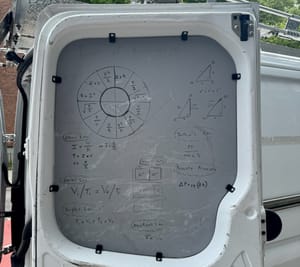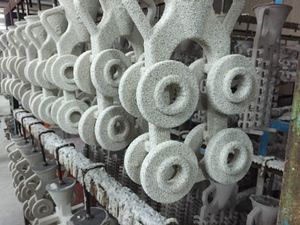A few weeks ago I sold a table saw to a random handyman from Queens. He drove down to pick it up in a neatly outfitted handyman van, a scuffed-up and worked-in vehicle with built-in cabinets lining the port bulwarks and a shiny lumber rack mounted to the roof. The van was nice, fine, a characteristic example of a mobile workshop, but what struck me about it was the Door of Knowledge scrawled inside the passenger side rear door. This fellow said that the Door of Knowledge preceded his ownership of the vehicle, and didn't seem to have much understanding of the principles embodied in it. But I loved it.
While working on a jobsite on a vacation during college, I remember using the Pythagorean Theorem (in particular, the fact that isosceles right triangles have sides with the ratio 1 : 1 : sqrt(2)) to calculate the length of a temporary knee brace. It was kind of revelatory: I had previously thought of math and the trades as distinct worlds, and was both embarrassed and proud to have found a way to merge them.
SCOPE CREEP.
- My notes on three books I've read recently.
With the SOW Members' Reading Group I'm currently reading Subprime Attention Crisis: Advertising and the Time Bomb at the Heart of the Internet by Tim Hwang, who is famously the busiest person on the internet and less famously also my lawyer. In spite of his business, Tim will be joining us to talk about the book on Monday, 2024-06-24.
Up next for the SOW Members' Reading Group: We'll be reading Nicola Twilley's brand new and (for me) long-awaited Frostbite: How Refrigeration Changed Our Food, Our Planet, and Ourselves. Nicky will also be joining us when we finish the book; you really should join us, too 💘
What else: I'm currently listening to John McPhee's Tabula Rasa, Volume 1, and Virginia Sole-Smith's Fat Talk: Parenting in the Age of Diet Culture, and I swear I'll finish Maylis De Kerangal's Birth of a Bridge on the beach at some point this summer. - After I wrote about the Memory Palace I'm constructing for small parts storage, a reader write in to suggest that I might have better recall if I didn't use a digital cataloging system in the first place. This is a valid suggestion, but after some consideration I came to the following:
I think of my alphanumeric drawer names (e.g.tray09-01-A) like a numbered city grid. I know that a particular restaurant is somewhere between second street and fourth street, but which one evades me; similarly I might remember that there are some M5 x 15 mm button head screws in eithertray02,tray03, ortray04. Meanwhile I can recall specifically that a different restaurant is on Prince rather than Spring, and the tattoo shops are definitely on St. Mark's, etc. My goal in giving my parts drawers new nicknames is to encourage a similar level of recall.
Who knows how this will turn out. But anyway, it's kind of fun thinking about my bike parts hanging out in front of the French pastry truck that parks on Eastern Parkway and Franklin Ave ;)
- The New York Times visits a modular housing factory in Sweden. This article has a ton of stuff in it, but a number of quotes struck me as inconsistent with my experience. For instance, "Building codes in the U.S. try to make buildings safe by prescribing exactly what materials must be used and how" (this may be true in places, but there are definitely performance-based standards in the US) and "During construction, work often halts for inspectors to make periodic visual inspections" (in NYC, inspectors often do "drive-by" inspections, in which they supposedly drive by your house, never entering and signing off on your work by default).
- According to a study of British data, electric cars are more likely to hit pedestrians than cars with internal combustion engines. The authors blame EV's tendency to be quiet, though I might suggest that blame lies with their surroundings' tendency to make a lot of noise. That is, electric vehicles are inaudible in a world filled with internal combustion engines. Take the combustion engines off the road, and I bet in a few years EVs will start to sound downright loud.
- A couple months ago, an old wooden tramway tower in Death Valley National Park was yanked out of the ground by someone who was stuck in the mud nearby. The tower was a hundred and thirteen years old, and was part of a tram that carried salt from the Saline Valley over the Inyo Mountains and into the Owens Valley. Here's a video of someone hiking the tramway in 2021, ogling its ruined alpine towers and then getting in a little over their head on a sketchy descent.
Over its thirteen-and-a-half-mile span the tram climbed over 1.4 miles in elevation; its maximum vertical angle was around 40°. It does not seem to have been a lucrative business venture. From the nomination form that was submitted (and subsequently accepted) to the National Register of Historic Places in 1974:
The construction of the tramway exhausted the Saline Valley Salt Company financially, and in 1915 the operation was leased to the Owens Valley Salt Company. This company produced salt until 1918 when it, too, went out of business... The Taylor Milling Company acquired the Saline Valley plant and produced some salt in 1920. After five years of inactivity the Sierra Salt Company was formed; and in 1926 salt was produced once more... The plant was last operated in 1930, and in 1935 the Sierra Salt Company went into receivership.
- Yesterday, I wrote for paid subscribers about a stormwater retention project that I'm undertaking at home. I'll be writing about this more in the coming months, but one interesting concept that came up during the draft process was the Manning formula, which estimates the average velocity of a liquid in open-channel flow. I only wish I had the information to calculate this for the public sewer in front of my house; it would be fun to merge this decidedly dirty project with a little bit of math.
Thanks as always to Scope of Work’s Members and Supporters for making this newsletter possible. Thanks also to Doug for helping source links this week.
Love, Spencer
p.s. - We care about inclusivity. Here’s what we’re doing about it.



